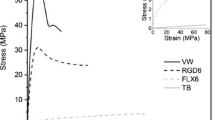Abstract
Since past three decades, direct printing of parts for various applications by the use of 3D-printing technology has gathered a lot of attention. However, many issues remain with the widespread applications of 3D-printed materials such as regulatory issues, sterile environment for part production, and the improvement of material properties with the desired structure. This article focuses on review of various post additive manufacturing processes to improve mechanical properties such as storage modulus and Young’s modulus and surface roughness. A heat treatment process after 3D printing was also discussed as potential method to achieve better mechanical properties by optimizing the crystalline structure of material. It was also reviewed that traditional AM technique produces products at a rapid rate and with minimum waste of materials and post processes could improve the surface finish as well as structure with higher strength in three dimensions.
Access this chapter
Tax calculation will be finalised at checkout
Purchases are for personal use only
Similar content being viewed by others
References
Coppola B, Cappetti N, Maio LD, Scarfato P, Incarnato L (2018) 3D Printing of PLA/clay nanocomposites influence of printing temperature on printed samples properties. Materials 11:2–17. https://doi.org/10.3390/ma11101947
Ngo TD, Kashani A, Imbalzano G, Nguyen KTQ, Hui D (2018) Additive manufacturing (3D printing): a review of materials, methods, applications and challenges. Composites B 143:172–196
Spoerk M, Gonzalez-Gutierrez J, Sapkota J, Schuschnigg S, Holzer C (2017) Effect of the printing bed temperature on the adhesion of parts produced by fused filament fabrication. Plast Rubber Compos 47(1):17–24. https://doi.org/10.1080/14658011.2017.1399531
Sun H, Wang SQ (2012) Shear and extensional rheology of entangled polymer melts: similarities and differences. Sci China Chem 55:779–786
Liao Y, Liu C, Coppola B, Barra G, Maio LD, Incarnato L, Lafdi K (2019) Effect of porosity and crystallinity on 3D printed PLA properties. Polymers (Basel) 11(9):1487. https://doi.org/10.3390/polym12010142
Karageorgiou V, Kaplan D (2005) Porosity of 3D biomaterial scaffolds and osteogenesis. Biomaterials 27:5474–5491. https://doi.org/10.1016/j.biomaterials.2005.02.002
Minas C, Carnelli D, Tervoort E, Studart AR (2016) 3D printing of emulsions and foams into hierarchical porous ceramics. Adv Mater 28(45):9993–9999
Pérez M, Medina-Sánchez G, García-Collado A, Gupta M, Carou D (2018) Surface quality enhancement of fused deposition modeling (FDM) printed samples based on the selection of critical printing parameters. Materials (Basel) 11(8):1382. https://doi.org/10.3390/ma11081382
Cho KL, Liaw II, Wu AHF, Lamb RN (2010) Influence of roughness on a transparent superhydrophobiccoating. J Phys Chem C 114:11228–11233
Kim HC, Kim DY, Lee1 JE, Park K (2017) Improvement of mechanical properties and surface finish of 3d-printed polylactic acid parts by constrained remelting. 8(12):1199–1203. https://doi.org/10.5185/amlett.2017.1686
Alsoufi MS, Elsayed AE (2017) War** deformation of desktop 3d printed parts manufactured by open source fused deposition modeling (FDM) system. Int J Mech Mechatron Eng 17(4):7–16
https://manufactur3dmag.com/common-problems-in-3d-printing-how-to-resolve-them-part-i/
Slavković V, Grujović N, Dišić A, Radovanović A (2017) Influence of annealing and printing directions on mechanical properties of pla shape memory polymer produced by fused deposition modeling. In: 6th International Congress of Serbian Society of Mechanics Mountain Tara, Serbia, pp 1–8
Braun TM, Schwartz DT (2016) The emerging role of electrodeposition in additive manufacturing. Electrochem Soc Interface 25(1):69–73
Carroll BE, Palmer TA, Beese AM (2015) Anisotropic tensile behavior of Ti–6Al–4V components fabricated with directed energy deposition additive manufacturing. Acta Mater 87:309–320
Mühler T, Gomes CM, Heinrich J, Günster J (2015) Slurry-based additive manufacturing of ceramics. Int J Appl Ceram Technol 12(1):18–25
Niendorf T, Leuders S, Riemer A, Richard HA, Tröster T, Schwarze D (2013) Highly anisotropic steel processed by selective laser melting. Metall Mater Trans B 44(4):794–796
Cooke W, Tomlinson RA, Burguete R, Johns D, Vanard G (2011) Anisotropy, homogeneity and ageing in an SLS polymer. Rapid Prototy** J 17(4):269–279
Guessasma S, Belhabib S, Nouri H, Hassana OB (2016) Anisotropic damage inferred to 3D printed polymer using fused deposition modelling and subject to severe compression. Eur Polymer J 85:324–340
Patterson AE (2016) Crack propagation in 3-D printed PLA: finite element modeling, test bed design, and preliminary experimental results. A Technical Report, University of Illinois at Urbana-Champaign
Zolfagharian A, Khosravani MR, Kaynak A (2020) Fracture resistance analysis of 3D-printed polymers. Polymers 12:302. https://doi.org/10.3390/polym12020302
https://www.gearbest.com/blog/how-to/how-3d-printing-fills-the-gap-between-the-outline-2992
Wach RA, Wolszczak P, Adamus-Wlodarczyk A (2018) Enhancement of mechanical properties of FDM-PLA Parts via thermal annealing. Macromol Mater Eng 303:1800169
Song Y, Li Y, Song W, Yee K, Lee KY, Tagarielli VL (2017) Measurements of the mechanical response ofunidirectional 3D-printed PLA. Mater Des 123:154–164
Author information
Authors and Affiliations
Editor information
Editors and Affiliations
Rights and permissions
Copyright information
© 2022 The Author(s), under exclusive license to Springer Nature Singapore Pte Ltd.
About this paper
Cite this paper
Pandey, B., Chalisgaonkar, R. (2022). A Review on Post Additive Manufacturing Techniques to Improve Product Quality. In: Dubey, A.K., Sachdeva, A., Mehta, M. (eds) Recent Trends in Industrial and Production Engineering. Lecture Notes in Mechanical Engineering. Springer, Singapore. https://doi.org/10.1007/978-981-16-3135-1_2
Download citation
DOI: https://doi.org/10.1007/978-981-16-3135-1_2
Published:
Publisher Name: Springer, Singapore
Print ISBN: 978-981-16-3134-4
Online ISBN: 978-981-16-3135-1
eBook Packages: EngineeringEngineering (R0)




